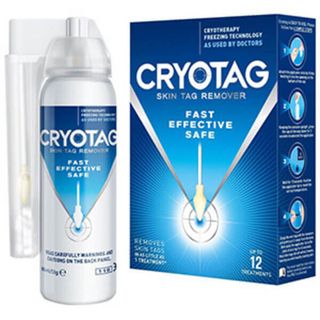
Skin Tags
Skin tags are a common part of ageing. They normally appear on parts of the body where the skin rubs together – think eyelids and armpits – and you’ll probably start to see them popping up from middle age onwards. Getting your first skin tag can be a bit of a shock, but don’t worry, they’re harmless. Unless they’re causing you pain or discomfort, or getting in your way, you don’t need to do anything about them. But if you do want to get rid of your tags, they can be removed safely and quickly.
Skin Tags Treatments
- Out Of Stock
 Cryotag Skin Tag Remover
Cryotag Skin Tag Remover
View recommended products for Skin Tags
Don't wait to get the medical help you need.
View our recommended treatments and select your preferred treatment and quantity from a list of options for you.
- Selected by our UK-based medical team
- Quick and easy checkout
- Treatments dispatched same day (before 3pm)
Ordering as easy as 1, 2, 3
1. Find the ideal treatment
2. Get a free consultation
3. Enjoy speedy delivery
Advice for Skin Tags
What are skin tags and what causes them?
Skin tags are benign skin tumours that typically appear in various places around the body where two stretches of skin rub against each other. They consist of clusters of collagen fibres and blood vessels surrounded by skin. It’s not fully understood what causes them, but they develop through excess skin growth, and that can certainly be caused by frequent abrasion.
It’s perfectly normal for an adult to contend with multiple skin tags as they age, and they’re not generally indicative of poor health. Those who develop skin tags will often choose to leave them alone because they don’t tend to be painful in themselves, but they can snag on items of clothing or pieces of jewellery, potentially leading to painful skin tears.
How are skin tags diagnosed?
A skin tag will typically appear as a small growth of skin cells (ranging from a few millimetres to several centimetres) hanging from the body via a stem of skin tissue. Colouring will vary: most often a skin tag will be the same colour as the healthy skin, but it can be substantially darker.
Working to diagnose skin tags is a matter of ruling out other growths that can resemble skin tags. A skin tag can look similar to a wart, for instance, or even a mole. Where warts are rough and hard, skin tags are smooth and soft. And while moles are solidly lodged in the skin, skin tags hang from it, making them relatively fairly easy to move.
Once someone has developed a couple of skin tags, they’ll know how to recognise their own, at least, and will most likely refrain from seeking medical assistance unless things worsen (the growth of large skin tags can be particularly annoying).
How can I treat skin tags?
Most skin tags don’t need to be removed. Since skin tags are harmless, any that don’t get in the way might as well be left alone. But when skin tags affect someone’s physical or mental health (through catching on things and tearing or affecting their self-esteem, respectively), they should be treated. Thankfully, it’s relatively easy to have a skin tag completely removed.
Removing skin tags can be done in various ways. One of the easiest options is to freeze them off using treatments like Cryotag: freezing the stalk of a skin tag kills the tissue, leading to the skin tag eventually falling off without any further effort. It’s also possible to burn the tissue instead, though freezing is generally preferable for skin tag removal.
If you don’t want to use such a treatment, and you’re dealing with a very small skin tag, you can attempt to cut off the blood circulation. Tying a piece of string tightly around the base of the tag (dental floss can work well) will prevent blood from reaching it, leading the tissue to die and fall off in due course. As noted, though, this should only be tried with small skin tags.
Where some skin tags fall off when treated, however, some are far tougher to address. Trying to remove large skin tags can easily cause damage to the normal skin surrounding them. Those who don’t see viable options should have their skin tags medically reviewed. If healthcare professionals agree that it’s warranted, they can arrange surgical removal.
How can I prevent skin tags?
While developing skin tags is often part of the ageing process, there are some things you can do to make them less likely to appear. Here are two key tips:
- Maintain a healthy weight. Fat and skin folds often produce skin tags through the skin rubbing together, so the biggest thing you can do is keep your weight under control. This is also good advice for keeping other skin diseases (such as eczema) at bay, since they tend to thrive in those conditions.
- Minimise skin friction. If you get a lot of exercise, it can lead to skin friction that can set the stage for skin tags. Consider applying powders that can reduce that friction: this will also help alleviate discomfort and issues such as blisters or warts.